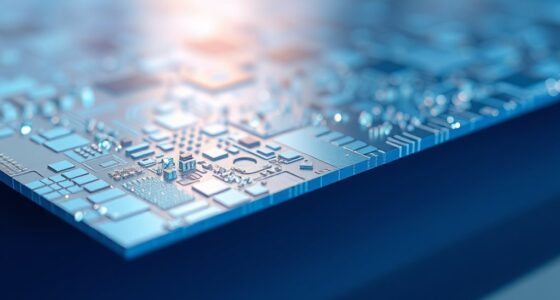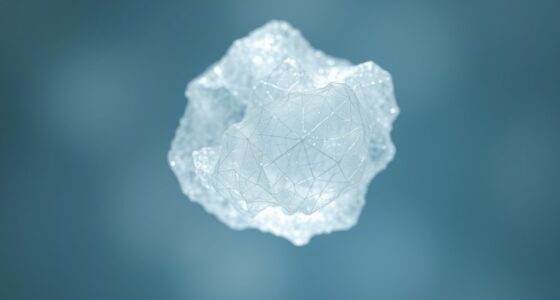Phase-change materials (PCMs) store and release thermal energy through phase transitions, mainly from solid to liquid. They absorb large amounts of latent heat, helping regulate temperatures in buildings, industrial processes, and transportation. Organic, inorganic, and hybrid PCMs are tailored for specific temperature ranges. Advances focus on improving thermal conductivity, stability, and encapsulation. If you continue exploring, you’ll discover how innovative PCM designs are transforming energy storage and management across various fields.
Key Takeaways
- PCMs store and release thermal energy through solid-liquid phase transitions, utilizing latent heat for efficient energy storage.
- They maintain near-constant temperatures during phase change, making them ideal for thermal regulation in buildings and industrial processes.
- Organic, inorganic, and eutectic PCMs can be tailored for specific temperature ranges and applications.
- Enhancements like composite materials and nanomaterials improve thermal conductivity and stability of PCMs.
- Encapsulation and structural management strategies prevent leakage and ensure long-term performance in energy storage systems.
Understanding the Fundamentals of Phase-Change Materials

Understanding the fundamentals of phase-change materials (PCMs) begins with recognizing how they store and release energy through phase shifts. When a PCM transitions between solid and liquid states, it absorbs or releases heat, mainly through latent heat, which is much higher than sensible heat. Legislative changes can influence the development and application of these materials. This process involves changes in internal structure or crystalline arrangements, enabling the material to hold large amounts of energy at a specific temperature. As the PCM reaches its phase-change temperature, it acts as an isothermal heat source or sink, making it highly efficient for thermal energy storage. The energy stored during melting or solidifying can be used later for heating or cooling purposes. These properties allow PCMs to manage thermal energy effectively across various applications.
Types and Classifications of PCM Substances

Phase-change materials (PCMs) can be categorized into several types based on their chemical composition and physical properties. Organic PCMs, derived from petroleum, plants, or animals, include paraffin and fatty acids, offering stability and cost-effectiveness. Organic PCMs are particularly popular in building applications due to their ability to absorb and release heat efficiently.
Organic PCMs from petroleum, plants, or animals provide stable, cost-effective thermal energy storage solutions.
Inorganic PCMs, mainly salt hydrates and metal alloys, are known for their high thermal conductivity and energy storage capacity, suitable for high-temperature applications. These materials often require encapsulation to prevent corrosion or phase separation, enhancing their longevity.
Eutectic PCMs combine organic and inorganic materials to fine-tune melting points for specific uses. This combination allows for customizable thermal properties to meet diverse application requirements.
You’ll find solid/solid PCMs that change phase within a solid state, avoiding melting issues, and high-temperature salts used in industrial settings. Solid/solid PCMs also benefit from reduced leakage problems compared to liquid-based systems.
Classification also depends on temperature ranges, such as low, medium, or high, aligning with diverse applications like building insulation, thermal systems, or cold chain logistics. Understanding these categories helps in selecting the appropriate PCM for each specific thermal energy storage need.
Additionally, understanding the underlying principles of the Law of Attraction can enhance motivation and mindset when working with thermal energy storage projects. Applying mindful decluttering strategies can also help manage the complexity of project components and enhance focus.
How PCMs Store and Release Thermal Energy

How do PCMs efficiently store and release thermal energy? They do this through latent heat, which occurs during phase transitions, mainly melting from solid to liquid.
When you heat a PCM to its phase-change temperature, it absorbs a large amount of energy without increasing its temperature, thanks to its high latent heat capacity. This energy is stored as enthalpy change during melting. Additionally, this process benefits from material stability, ensuring repeated phase transitions without degradation over time. Maintaining this stability is crucial for long-term performance and reliability in energy storage systems.
When cooling, the PCM solidifies, releasing the stored latent heat back into the environment, keeping the temperature nearly constant. This process allows PCMs to act as thermal reservoirs, providing steady heat release. The efficiency of this process can be further enhanced through system integration, which optimizes energy transfer and control.
Outside the phase change, sensible heat helps store and release energy, but latent heat dominates, making PCMs highly efficient for thermal energy management. Furthermore, advancements in automation technologies are improving the integration and control of PCM-based systems in various applications.
Practical Uses of PCMs in Building and Industrial Applications
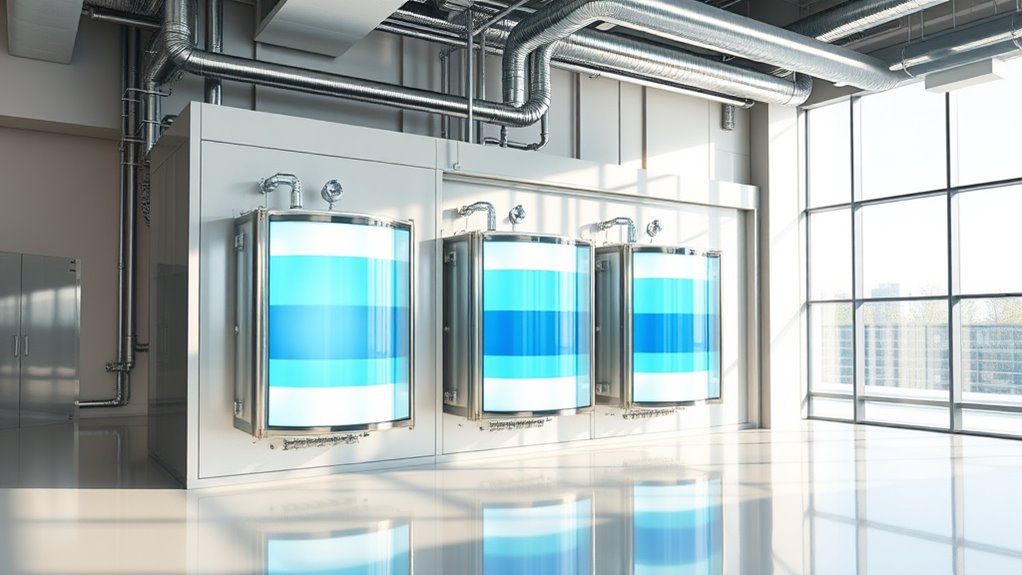
Practical applications of PCMs in building and industrial settings harness their ability to regulate temperature and improve energy efficiency.
In buildings, PCMs maintain indoor comfort by absorbing excess heat during the day and releasing it at night, reducing cooling and heating demands. They help lower peak energy loads and can cut overall energy use by up to 30%. Common materials like paraffin wax, organic compounds, and salts are chosen for their suitable melting points and compatibility. Seasonal Energy Efficiency Ratio (SEER) ratings indicate cooling efficiency and can be used to assess the performance of systems integrated with PCMs. Additionally, the integration of thermal management strategies enhances the effectiveness of PCM systems in various environments. Understanding regional architectural styles can guide the selection of appropriate PCM materials for specific climates.
PCMs act as thermal mass, storing heat with less bulk than traditional materials.
In industrial settings, PCMs control process temperatures, recover heat, and support cooling systems. They also play an essential role in transporting temperature-sensitive products, enhancing operational efficiency and reducing energy costs.
Overcoming Challenges in PCM Performance and Durability

While PCMs offer significant benefits in regulating temperature and boosting energy efficiency, their performance can be hindered by several challenges. Low thermal conductivity limits heat transfer, but this can be addressed with composite materials, metallic or carbon-based fillers, and nanomaterials to enhance thermal performance.
Achieving uniform melting is also critical; phase separation and non-uniform melting can reduce efficiency. Proper thermal control and innovative material design help ensure consistent phase change behavior.
Uniform melting ensures consistent energy storage and release, enhancing PCM efficiency and reliability.
Durability and cycle life depend on managing high-temperature exposure, preventing chemical degradation, and using effective containment to avoid leakage.
Supercooling, especially in salt hydrates, delays solidification; adding nucleation agents mitigates this.
Finally, safety concerns, like flammability, require careful material selection and protective measures to ensure long-term, reliable performance.
In addition, incorporating smart technology such as sensors and control systems can optimize PCM operation and improve overall system reliability.
Advances in PCM Technology and Material Innovation

Recent advances in PCM technology focus on developing innovative materials and formulations that enhance thermal performance and stability. Organic-inorganic composites improve thermal conductivity and durability, while microencapsulation of paraffin boosts energy storage efficiency and protects the core.
Salt hydrates offer high thermal conductivity and stability, suitable for diverse applications. Metal-organic frameworks (MOFs) enable tunable phase transitions and high storage densities. Eutectic mixtures are tailored to optimize phase transition temperatures.
Nano-enhanced PCMs with graphene or carbon nanotubes significantly boost thermal conductivity. Hybrid materials combine different components to improve properties, and novel organic compounds are designed for specific temperature ranges.
These innovations expand PCM capabilities, making them more effective and reliable for various energy storage solutions.
Designing Effective Encapsulation and Composite Systems
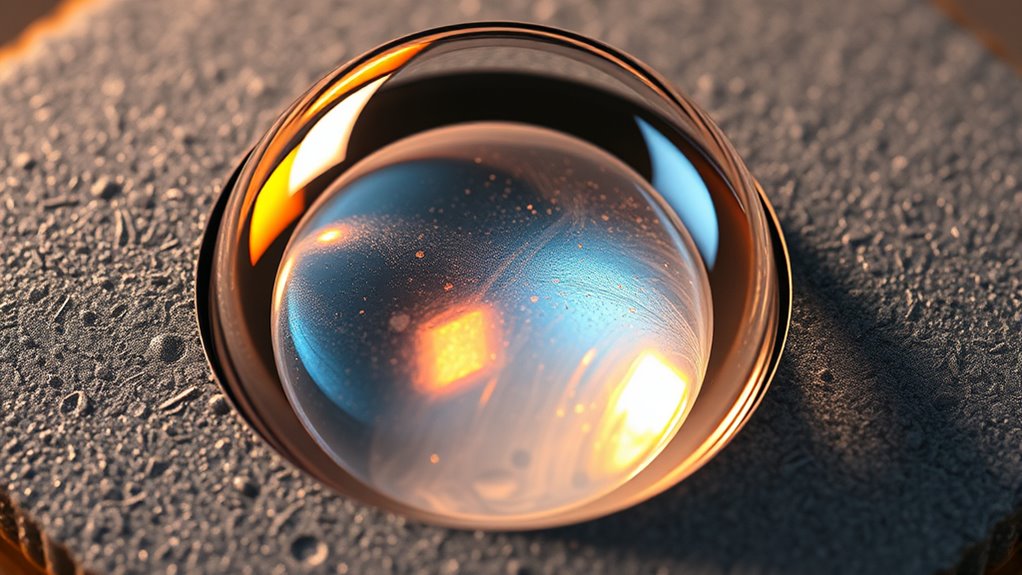
Designing effective encapsulation and composite systems is essential for maximizing the performance and durability of phase-change materials. You can use techniques like microfluidics for precise control over particle formation, ensuring efficient heat transfer. Spray drying produces core-shell capsules with enhanced mechanical resistance and thermal stability.
While electrospinning encapsulates PCMs within nanofibers for high thermal performance. Core-shell structures prevent leakage and protect against corrosion, with material choice—organic, inorganic, or hybrid—affecting mechanical and thermal properties.
In composite systems, selecting high-capacity core materials like lauric acid and robust shell materials such as polystyrene or silica improves thermal conductivity and structural integrity. Managing volume changes during phase progression is critical to prevent damage, ensuring long-term efficiency and consistent thermal energy storage performance.
Future Perspectives in Phase-Change Material Research
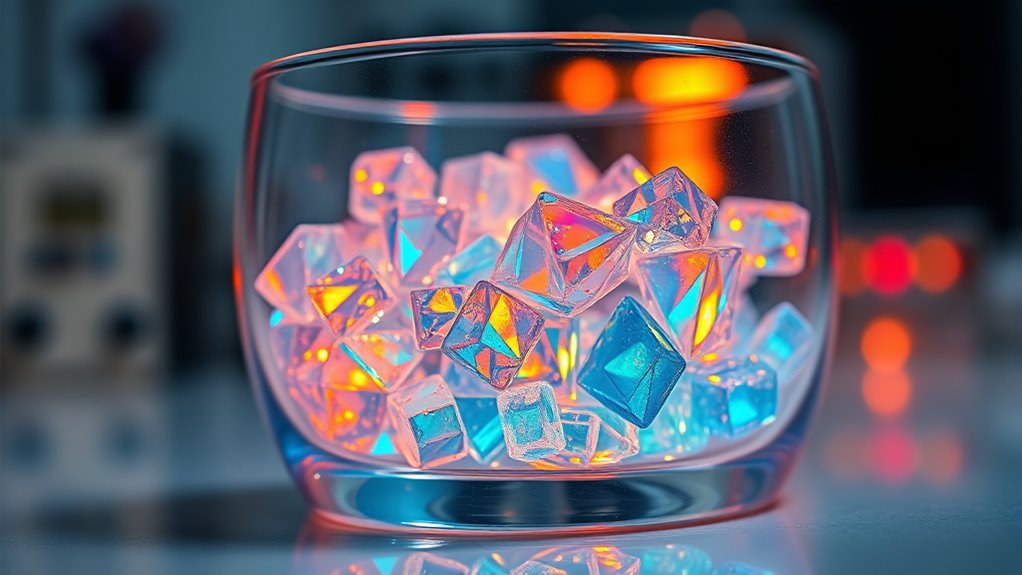
Innovations in encapsulation and composite systems are paving the way for more advanced phase-change materials (PCMs), inspiring future research directions. You’ll see bio-inspired designs emerge, addressing issues like leakage and low efficiency by mimicking nature’s strategies for thermal regulation. Biomimicry can lead to more sustainable, eco-friendly PCMs suitable for textiles, medical devices, and smart materials.
In photonics, PCMs are advancing in reconfigurable nanodevices and optical data storage, with deep learning optimizing device performance.
Energy-wise, future research aims to enhance thermal conductivity and integration with renewable systems, boosting waste heat recovery and building efficiency. You’ll also witness growing applications in biomedical devices and flexible electronics, where PCMs improve thermal management and device reliability, paving the way for smarter, more efficient technologies.
Frequently Asked Questions
What Are the Environmental Impacts of Widespread PCM Use?
You might wonder about the environmental impacts of widespread PCM use. While PCMs improve insulation and save energy, their production consumes more energy and involves chemical additives that can harm the environment.
Disposal options are limited, and resource extraction adds to environmental strain. If not handled properly, PCMs can cause pollution.
Balancing these benefits and challenges is key to ensuring sustainable, eco-friendly applications in your projects.
How Do Cost and Scalability Affect PCM Adoption?
You see that cost and scalability are key factors in adopting new technologies. When it comes to PCMs, high material costs, especially for organic options like paraffin waxes, limit their use in budget-sensitive markets.
Scalability challenges, such as stability and supply constraints, can slow deployment. To succeed, you need cost-effective, reliable PCMs that can be scaled up efficiently to meet growing energy management needs.
Can PCMS Be Safely Integrated Into Residential Building Materials?
You might wonder if PCMs can be safely integrated into your home. The good news is, with proper selection and encapsulation, they can be secure.
Organic PCMs like paraffin are generally fire-resistant, and layering helps prevent overheating. When correctly embedded in drywall, insulation, or façade materials, PCMs improve safety by maintaining stable indoor temperatures during extreme weather without increasing fire risk.
Proper standards and testing ensure their safe use in residential buildings.
What Are the Long-Term Stability Concerns for Different PCM Types?
You’re wondering about long-term stability concerns for different PCM types. Over time, repeated phase changes can cause material deterioration, especially if not properly encapsulated. Chemical issues like phase separation or additive degradation can reduce performance.
Physical factors such as low thermal conductivity and structural integrity also impact longevity. Ensuring proper encapsulation, selecting stable materials, and optimizing environmental conditions help maintain PCM effectiveness over many thermal cycles.
How Do Regulations Influence PCM Development and Application?
When you look at how regulations shape technology, it’s like guiding a craftsman shaping their masterpiece. You see, regulations encourage you to develop better, safer, and more sustainable solutions, pushing innovation in areas like temperature control and environmental impact.
They motivate you to improve material efficiency, adopt eco-friendly practices, and guarantee safety standards. This way, your work meets global expectations, making your solutions more reliable and market-ready in a competitive landscape.
Conclusion
As you explore phase-change materials, remember their potential to revolutionize energy storage—much like alchemists dreaming of turning lead into gold. By understanding their fundamentals, types, and applications, you can contribute to overcoming current challenges. With ongoing innovations and clever system designs, PCM technology is poised for a bright future. Embrace this journey, and you’ll help shape a more sustainable world where thermal energy is stored and released with the finesse of a modern-day wizard.


